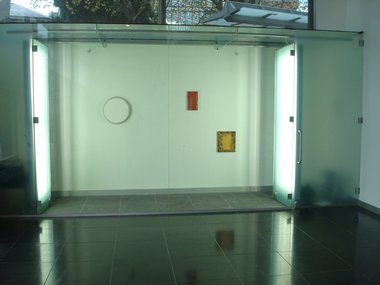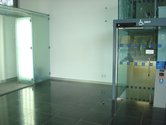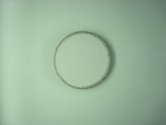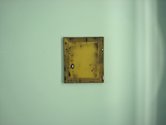John Hurrell – 24 May, 2012
Dwyer's presentation could be about the impact of the ubiquitous green glass on viewer perception of the paintings. The gallery glass is slightly tinted - enough to darken the tone of the white plaster in the bike tyre - and the glass of the nearby lift well for the disabled is considerably greener - sufficient to affect the mood of the foyer space where the very small two part painting is found.
Within the Window gallery and the foyer to the university library, Johl Dwyer presents a set of four paintings, three behind glass in the tall walk-in vitrine that makes up the ‘gallery proper’, and another high on an adjacent wall next to a glass lift well.
These works vary greatly in size and wall height; all involve plaster poured into various confining structures: a canvas stapled to a square stretcher, a small treaded bike tyre, a narrow wooden stretcher, and what seem to be a pair of circular curtain rod holders.
The circular works are unusual. The white wobbly-edged disc framed by the bike tyre has a stark presence while the two small cylinders in the foyer are in teal green and white plaster - with the latter seemingly coated with resin. They are vertically aligned (one below the other) and look like a pair of strange buttons projecting from the wall.
Dwyer’s right angled, straight-edged works are very different. The painting with the plaster in a wooden frame has had layers of paint vigorously sanded back to reveal specks, striations and a dry dusty coating of pastel-like red-oxide. The plaster within the other wider brown cedar stretcher is covered with a deep layer of honey coloured resin, and has a few dramatic white globs of paint on its surface. Inside its amber varnish are sprayed dark umber mesh textures that give it real presence. With a gorgeous Sigmar Polke feel, it radiates a warm glow. The show is an adventurous assortment that tests the conventions of what ‘built’ or complicatedly ‘constructed’ paintings might be.
As for the whole package, other than the intriguing peculiarities of each work Dwyer’s presentation could be about the impact of the ubiquitous green glass on viewer perception of the paintings. The gallery glass is slightly tinted - enough to darken the tone of the white plaster in the bike tyre - and the glass of the nearby lift well for the disabled is considerably greener - sufficient to affect the mood of the foyer space where the very small two part painting is found. (You’ll see what I mean if you look at these images.) The show’s title and installational concept (involving the foyer) seems to allude to the glass’s role in the space - it makes the enclosed gallery works a foil to the ‘directly viewed’ (but out of reach) two part painting outside it.
So is Dwyer critiquing the use of tinted glass in a gallery venue (saying it is a hindrance to intelligent examination and presentation of displays) or is he making some comment on the nature of representation or the properties of some of our senses? Perhaps that mediation is something we can not be free of, that it always prevents direct access, and that there can never be optical ‘transparency’ in particular anyway - only arbitrary visual correlations to the world outside our bodies. That it is a matter of degree, the gallery glass paralleling our eyes and brain, and that that tinted layer is a symbol for this philosophical/perceptual impedance.
John Hurrell





 Advertising in this column
Advertising in this column Two Rooms presents a program of residencies and projects
Two Rooms presents a program of residencies and projects



This Discussion has 0 comments.
Comment
Participate
Register to Participate.
Sign in
Sign in to an existing account.